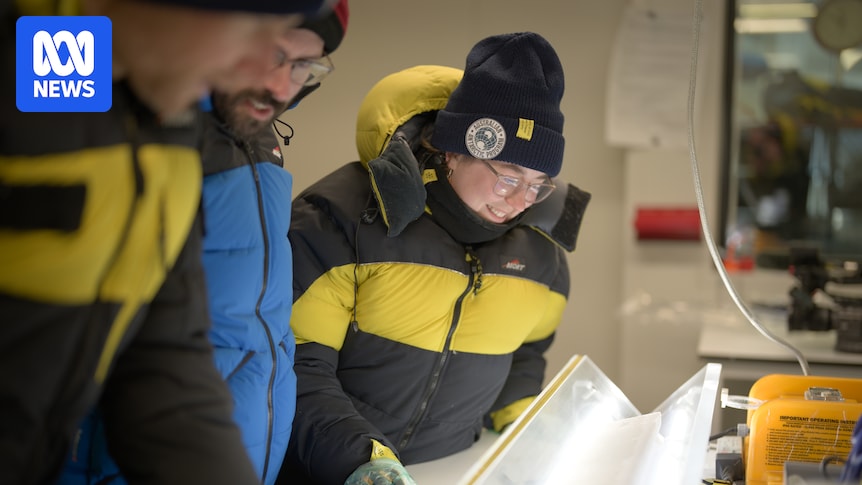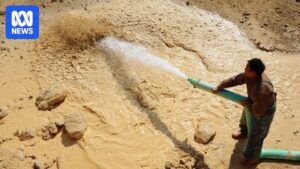
Inside an ice-cold laboratory in Hobart, where the temperature is almost 20 degrees Celsius below zero, scientists clad in thick puffer jackets embark on a groundbreaking task. With gloved hands, they carefully extract a one-metre cylinder of ice from an insulated box that recently arrived from Antarctica. This marks the beginning of a significant scientific endeavor.
“In the freezer lab today, we’re cutting the first samples from the ‘Million Year Ice Core’,” explained Joel Pedro, the lead scientist on the project. “And that’s a big moment for us.”
The Ambitious ‘Million Year Ice Core’ Project
For nearly a decade, paleoclimatologist Joel Pedro and a team from the Australian Antarctic Program have been orchestrating this ambitious project. The goal is to extract the world’s oldest, continuous core of ice from deep beneath the Antarctic ice sheet. Known as the “Million Year Ice Core,” this project aims to unlock secrets of Earth’s climatic past.
“More than any other archive of climate in the past, ice cores have a range of information that helps you to understand the changes in the total climate system,” Dr. Pedro elaborated. In essence, ice cores serve as time capsules, offering scientists a clear picture of Earth’s climate and atmospheric history through the tiny bubbles of air trapped within them over millennia.
“Those air bubbles are a sample of the atmosphere in the past that was trapped as snow fell and was then compressed into ice,” Dr. Pedro said.
Initial Findings and Future Goals
The ice currently under analysis in Hobart comes from a depth of 150 meters, making it almost 4,000 years old. While this is a significant milestone, it represents only the beginning of a much larger mission. Over the coming years, the team hopes to reach a depth of 3,000 meters, potentially recovering the oldest ice ever.
“We’re hoping to push the climate record back well over a million years, potentially up to 2 million years,” Dr. Pedro stated.
Challenges of the Grueling Mission
The journey to this point has been a monumental logistical challenge. The drill site, Dome C North, is located 1,200 kilometers from the nearest Australian station in Antarctica and sits 3,000 meters above sea level, where temperatures can plummet below -50 degrees Celsius. Establishing a deep field station required a 10-person team to use six tractors to haul nearly 600 tonnes of equipment across the frozen landscape.
“In the Australian program, it’s the biggest traverse that we’ve undertaken,” said Chris Gallagher, the traverse leader from the Australian Antarctic Division.
After enduring multiple blizzards, the team reached Dome C North 18 days after departing from Casey Station. “It’s a very specialized team with extremely high skills, but also the ability to really get on with each other and care for each other,” Mr. Gallagher noted. “We were like a big family on this trip.”
Scientific and Global Implications
Currently, the oldest ice core on record dates back almost 800,000 years. However, a European team, known as Beyond EPICA, recently extracted ice from a depth of 2,800 meters, expected to date back nearly 1.2 million years. The Australian team plans to drill more than 200 meters deeper than Beyond EPICA, which Dr. Pedro suggests could date back up to 2 million years.
“If we can get this record − and the modeling suggests Dome C North is the best site in Antarctica for recovering the oldest ice − then we’ll produce data that will stand for decades as the measurement of Earth’s atmosphere and greenhouse gas levels through that period,” Dr. Pedro said. “It’s pretty exciting.”
If successful, this data could help scientists better understand why Earth’s ice ages became significantly longer about a million years ago. “It remains one of the biggest puzzles, or challenges, in ice core science and climate science to resolve what the cause of that was, and, in particular, what the role of CO2 was in that,” Dr. Pedro explained.
Data from the “Million Year Ice Core” could also enhance the accuracy of climate change forecasts. The team plans to resume drilling during the 2025/26 summer and expects to reach the 3,000-meter mark by 2028/29, potentially unlocking new insights into Earth’s climatic history.







